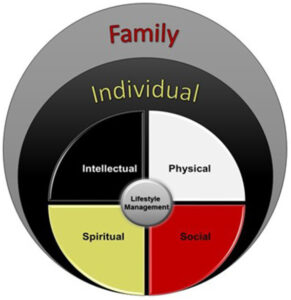Chapter 1. Introduction to Nutrition
Nutrition and Health
How Does Nutrition Contribute to Health?
There are numerous things that contribute to an individual’s overall health. While some nations choose not to use the Medicine Wheel because it can be seen as a colonial structure [1], it has been used by generations of Indigenous groups for health and healing [2]. The Medicine Wheel has four directions, and while different groups interpret the four directions differently [3], some interpretations suggest that the four aspects represent the physical, the mental, the emotional, and the spiritual, while others suggest the four aspects are physical, social, spiritual, and intellectual [4]. Irrespective of the parts, it’s important that each pilar is balanced for us to be happy and healthy [5]. Furthermore, others may suggest that occupational and social health are also important to overall health, and these two concepts could also form the basis for wellness in the four dimensions of the Medicine Wheel.

Nutrition is one aspect that plays a role in our physical health, but given the social connectedness that we can experience while eating with others, it could also play a role in our spiritual and emotional health.
A healthy diet can prevent some diseases and reduce your risk of others. For example, diseases such as rickets, pellagra, and anemia, are caused by nutrient deficiencies. A healthy diet can also play a role in preventing other diseases such as heart disease, type 2 diabetes, and osteoporosis, as well as premature death.
Combining Indigenous and Modern-Day Practices and Food Systems
Indigenous food systems are known for being rich in resources and nourishment, and promoting biocultural knowledge and environmentally conscious ways of living. However, due to colonization and the challenges presented by modern-day unsustainable food production and overconsumption, Indigenous food systems are disappearing at an alarming rate [6].
Jared Qwustenuxn Williams, an Indigenous cultural educator, talks about changes to the traditional food systems of the hwulmuhw (First Nations) people as seen in modern-day diets. Williams highlights that during ‘canning,’ which is commonly used to preserve traditional foods, straight salts were traditionally used as the only form of seasoning for canning meats such as smoked salmon. However, due to the changes brought by modern hwunitum (Non-First Nations) food systems, hwulmuhw people have adapted to using different peppers, hot sauces, and other hwunitum resources for canning meats. Williams mentions that these changes in traditional food systems will continue to progress due to the constantly evolving nature of culture [7]. With that being said, the example of ‘canning’ perfectly showcases that there are ways to combine traditional hwulmuhw practices (i.e.. canning) with modern hwunitum food systems (i.e.. different spices/sauces) to adapt to newer resources while also preserving traditional Indigenous practices.
Media Attributions
- https://healthydebate.ca/2018/10/topic/medicine-wheel/ ↵
- https://www.nlm.nih.gov/nativevoices/exhibition/healing-ways/medicine-ways/medicine-wheel.html ↵
- https://www.nlm.nih.gov/nativevoices/exhibition/healing-ways/medicine-ways/medicine-wheel.html ↵
- Greer, T. and Lemacks, JL. Front Public Health . 2024 Jul 19;12:1392517. doi: 10.3389/fpubh.2024.1392517 ↵
- https://healthydebate.ca/2018/10/topic/medicine-wheel/ ↵
- Kuhnlein, H. & Chotiboriboon, S. (2022). Why and How to Strengthen Indigenous Peoples’ Food Systems With Examples From Two Unique Indigenous Communities. Frontiers in Sustainable Food Systems, 6. https://doi.org/10.3389/fsufs.2022.808670 ↵
- Williams, J. (2021). “Coast Salish foods of today: evolving towards a new path.” The Discourse. https://thediscourse.ca/cowichan-valley/coast-salish-food-today ↵

